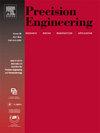Improvement of electrochemical drilling deep holes using combinatorial tube electrode with a suitable leading flow structure
IF 3.5
2区 工程技术
Q2 ENGINEERING, MANUFACTURING
Precision Engineering-Journal of the International Societies for Precision Engineering and Nanotechnology
Pub Date : 2025-04-16
DOI:10.1016/j.precisioneng.2025.04.017
引用次数: 0
Abstract
Deep holes with high quality are extensively demanded in such industrial applications as aviation. Electrochemical drilling (ECD) is a promising technique for fabricating deep holes in difficult-to-machine materials. However, at the initial machining stage, the electrolyte flow in the inter-electrode gap changes dramatically from expansion flow to converging flow, which may affect the machining process. To address this, a leading flow structure is developed to confine the electrolyte flow when machining the hole entrance, which helps to improve processing stability. A height of 10.0 mm for the leading flow structure is found to be sufficient for ensuring the fine entrance profile and machining stability. Furthermore, the normal tube electrode commonly causes misdistribution of electrolyte flow and current density at the hole bottom, generating defects such as spikes and striations, which limits its application in deep holes requiring a flat bottom. Therefore, a combinatorial tube electrode is proposed to enhance the distribution of flow and electric fields by changing the cross-section at the tube tip, resulting in a defect-free flat bottom. Based on these findings, two typical deep holes, a through hole and a flat-bottomed blind hole, were successfully fabricated with high quality, as so the machining capability and processing stability had been prominently enhanced.

采用合适导流结构的组合管电极改进电化学钻深孔
高质量的深孔在航空等工业应用中有着广泛的需求。电化学钻孔(ECD)是一种在难加工材料上制造深孔的有前途的技术。然而,在加工初期,电极间隙内的电解液流动由膨胀流动急剧转变为收敛流动,这可能会影响加工过程。为了解决这一问题,设计了一种导流结构,在加工孔入口时限制电解液的流动,有助于提高加工稳定性。10.0 mm的导流结构高度足以保证良好的入口轮廓和加工稳定性。此外,普通管电极通常会导致孔底电解质流动和电流密度分布不均,产生尖峰和条纹等缺陷,这限制了其在需要平底的深孔中的应用。因此,提出了一种组合管电极,通过改变管端截面来增强流场和电场的分布,从而获得无缺陷的平底。在此基础上,成功制备了两个典型的深孔,即通孔和平底盲孔,并获得了高质量的加工,从而显著提高了加工能力和加工稳定性。
本文章由计算机程序翻译,如有差异,请以英文原文为准。
求助全文
约1分钟内获得全文
求助全文
来源期刊
CiteScore
7.40
自引率
5.60%
发文量
177
审稿时长
46 days
期刊介绍:
Precision Engineering - Journal of the International Societies for Precision Engineering and Nanotechnology is devoted to the multidisciplinary study and practice of high accuracy engineering, metrology, and manufacturing. The journal takes an integrated approach to all subjects related to research, design, manufacture, performance validation, and application of high precision machines, instruments, and components, including fundamental and applied research and development in manufacturing processes, fabrication technology, and advanced measurement science. The scope includes precision-engineered systems and supporting metrology over the full range of length scales, from atom-based nanotechnology and advanced lithographic technology to large-scale systems, including optical and radio telescopes and macrometrology.

 求助内容:
求助内容: 应助结果提醒方式:
应助结果提醒方式:


